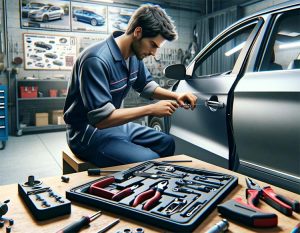The functionality of a car door latch is something most people take for granted until they encounter a problem. These mechanisms are pivotal not only for the convenience of entering and exiting the vehicle but also for the safety and security of those inside. A malfunctioning car door latch can lead to doors that won’t close properly, doors that won’t open, or even doors that could unexpectedly open while driving. The causes of these issues can range from simple dirt accumulation to more complex mechanical failures. Given the variety of car models and latch designs, the approach to fixing a car door latch may vary, but the fundamentals remain the same. This guide aims to equip you with the knowledge and steps necessary to tackle most common latch problems, ensuring your vehicle remains safe and functional.
Tools and Materials You Will Need
Before embarking on the journey to fix your car door latch, it’s crucial to prepare by gathering the right tools and materials. Here’s what you’ll typically need:
- Screwdrivers (Phillips and flat-head) to remove any screws.
- WD-40 or a similar lubricant to address any stiffness or squeaking.
- Needle-nose pliers for any small or difficult-to-reach components.
- A new door latch (if replacement is necessary), which should be specific to your vehicle’s make and model.
Having these tools and materials at hand before you start can save you time and make the process smoother. Remember, using the right tools not only helps in effectively fixing the problem but also prevents any accidental damage to your vehicle’s door and its components.
Step-by-Step Guide to Fixing a Car Door Latch
Before diving into the repair process, it’s crucial to understand that fixing a car door latch might require patience and attention to detail. Each step should be followed carefully to avoid further damage to the door or the latch mechanism.
-
Diagnose the Problem: Begin by identifying the specific issue with the door latch. Whether it’s sticking, failing to catch, or seems entirely broken, understanding the problem will guide your repair strategy.
-
Clean and Lubricate: Dirt, grime, and rust are common culprits behind a malfunctioning latch. Using a lubricant like WD-40, spray the latch mechanism thoroughly. After applying the lubricant, open and close the door multiple times. This action helps work the lubricant into the moving parts of the latch, potentially resolving any sticking or jamming issues without the need for further repairs.
-
Tighten or Replace Screws: Loose hardware can also lead to latch problems. Inspect the latch assembly and tighten any loose screws with a screwdriver. If you discover stripped or missing screws, replacing them is crucial to ensure the latch can operate correctly.
-
Replace the Latch: If the latch is beyond repair, replacing it might be the only solution. Start by removing the door panel to gain access to the latch assembly. Carefully unscrew the old latch, taking note of its placement and how it’s connected. Replace it with a new latch, ensuring it’s properly aligned and secured before reassembling the door panel.
After completing these steps, test the door several times to ensure the latch is operating smoothly. If problems persist, you may need to delve deeper into troubleshooting or consider seeking professional assistance.
Troubleshooting Common Car Door Latch Problems
Even with a well-maintained vehicle, door latch issues can arise, often due to misalignment, wear, or damage to the latch mechanism itself. When cleaning and lubricating the latch doesn’t resolve the issue, further investigation is required. Misalignment between the door latch and the striker plate is a common problem, especially after an accident or due to worn hinges. Carefully inspect the alignment, adjusting the striker plate if necessary to ensure a proper latch. Additionally, the connection between the door handle mechanism and the latch could be compromised. This disconnection often results from a broken link or spring within the door panel, necessitating a more detailed inspection and potentially complex repairs.
When to Seek Professional Help
While many latch problems can be addressed with DIY methods, there are scenarios where professional help is indispensable. This is particularly true for modern vehicles equipped with electronic locks and sophisticated security systems. If your troubleshooting efforts do not resolve the issue, or if you’re uncomfortable dismantling the door panel and handling the latch mechanism, consulting with a professional mechanic is advisable. Professionals have the tools, expertise, and experience to diagnose and fix door latch issues efficiently, ensuring your vehicle’s security and functionality are restored without risking further damage.
Conclusion
Repairing a car door latch can often be achieved with some basic tools and a systematic approach. From diagnosing the problem to implementing a fix, each step is crucial for restoring the functionality and security of the car door. However, recognizing when to call in a professional is equally important, as some issues may require specialized knowledge or equipment. For those looking to further enhance their vehicle, particularly Jeep owners, incorporating the best Jeep half tube doors can add both style and functionality, offering increased visibility and a rugged look while maintaining safety. Such upgrades, discussed in another one of our articles, complement the practical aspects of vehicle maintenance with aesthetic improvements, ensuring your vehicle remains in top condition, secure, and enjoyable to drive.


 Clean and Lubricate: Dirt, grime, and rust are common culprits behind a malfunctioning latch. Using a lubricant like WD-40, spray the latch mechanism thoroughly. After applying the lubricant, open and close the door multiple times. This action helps work the lubricant into the moving parts of the latch, potentially resolving any sticking or jamming issues without the need for further repairs.
Clean and Lubricate: Dirt, grime, and rust are common culprits behind a malfunctioning latch. Using a lubricant like WD-40, spray the latch mechanism thoroughly. After applying the lubricant, open and close the door multiple times. This action helps work the lubricant into the moving parts of the latch, potentially resolving any sticking or jamming issues without the need for further repairs.